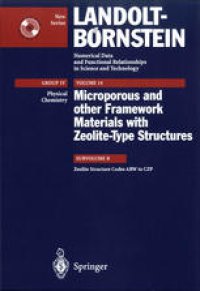
Ebook: Zeolite Structure Codes ABW to CZP
Author: W. H. Baur R. X. Fischer (eds.)
- Tags: Landolt-Börnstein, Mechanics Fluids Thermodynamics, Physical Chemistry
- Series: Landolt-Börnstein - Group IV Physical Chemistry 14B : Physical Chemistry
- Year: 2000
- Publisher: Springer-Verlag Berlin Heidelberg
- Edition: 1
- Language: English
- pdf
Zeolites and zeolite-like became important because of their ion exchange capacities and their outstanding catalytic properties. Millions of tons of zeolites have been produced in the past years for the oil refining industry alone and, in even greater quantities, as ion-exchanging softening agents for detergents. Numerous other applications, e.g. in environmental protection, farming, gas separation, medicine, and pharmacy, are known, making zeolites almost a necessity of daily life. Consequently, there are many, research activities dealing with zeolites properties and characterization. However, a strictly systematic description of zeolite-type crystal structures was not available but is now presented in this series of volumes. It is disigned as a reference work for zeolite chemists and materials scientists, but it also serves as a tool to interpret structural similarities and to derive new structures from known topologies.
Zeolites and zeolite-like became important because of their ion exchange capacities and their outstanding catalytic properties. Millions of tons of zeolites have been produced in the past years for the oil refining industry alone and, in even greater quantities, as ion-exchanging softening agents for detergents. Numerous other applications, e.g. in environmental protection, farming, gas separation, medicine, and pharmacy, are known, making zeolites almost a necessity of daily life. Consequently, there are many, research activities dealing with zeolites properties and characterization. However, a strictly systematic description of zeolite-type crystal structures was not available but is now presented in this series of volumes. It is disigned as a reference work for zeolite chemists and materials scientists, but it also serves as a tool to interpret structural similarities and to derive new structures from known topologies.